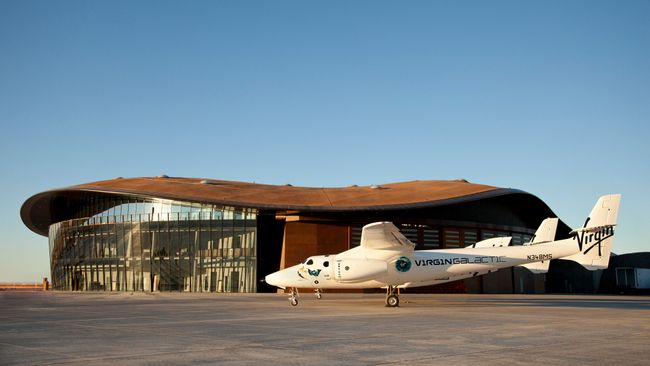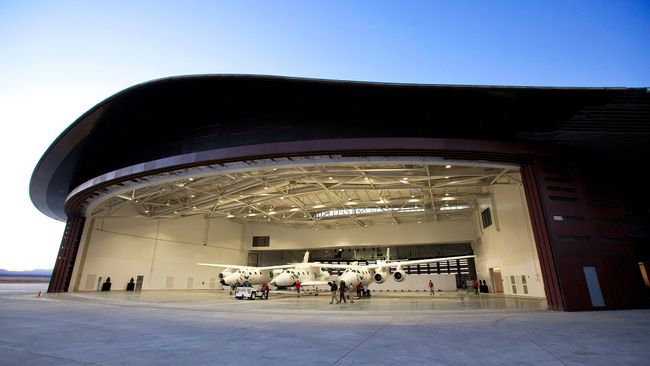Virgin Galactic's home for tourist spaceflights is go for launch.
SPACEPORT AMERICA, N.M. - Virgin Galactic's new home for tourist flights to suborbital space is now go for launch.
The spaceflight company unveiled the mostly completed interior of its "Gateway to Space" building here at Spaceport America today (Aug. 15), showcasing communal areas where passengers will gear up for their flights as well as the spaceflight-operations sector housing mission control.
The progress on this interior work "means that Spaceport America's Gateway to Space is now functionally operational - ready to host the remaining portion of Virgin Galactic's test-flight program before welcoming its very first future astronauts," Virgin Galactic representatives said in a statement today.
"It's just a wonderful, special day for us," Virgin Galactic CEO George Whitesides told reporters here this morning. "It's just a really important day, to share with you some of the progress and to declare operational readiness."

Virgin Galactic unveiled the first look at its Gateway to Space terminal for space tourists flights at Spaceport America near Truth or Consequences, New Mexico on Aug. 15, 2019.

Marching toward commercial flight
Virgin Galactic's spaceflight system consists of a carrier aircraft called WhiteKnightTwo and the six-passenger SpaceShipTwo space plane. WhiteKnightTwo takes off from a runway, hauling the space plane up to an altitude of about 50,000 feet (15,000 meters). At that point, SpaceShipTwo drops free and engages its rocket motor, powering itself to suborbital space.
Passengers aboard the space plane will experience a few minutes of weightlessness and get great views of Earth against the blackness of space before returning to Earth for a runway landing.
A ticket to ride SpaceShipTwo currently costs $250,000, and more than 600 people have put down a deposit to reserve a seat, Virgin Galactic representatives have said.
The company is well into the test-flight program with the current iterations of WhiteKnightTwo and SpaceShipTwo, which are known as VMS Eve and VSS Unity, respectively. Unity reached suborbital space for the first time in December 2018 and did it again in February of this year, earning five people - pilots Mark "Forger" Stucky, CJ Sturckow, Dave Mackay and Mike "Sooch" Masucci, and chief astronaut instructor Beth Moses - their commercial astronaut wings.
Those landmark flights, and the others leading up to them, took off from Mojave Air and Space Port in southeastern California. But the final phases of the test campaign will be carried out here in New Mexico.
Indeed, VMS Eve arrived at Spaceport America earlier this week and took off on a test flight this morning (without VSS Unity, which is still in Mojave).
"In the coming days, the team will use VMS Eve to fly simulated spaceship launch missions, with pilots and Mission Control ensuring that all in-flight communications and airspace coordination work as planned," Mackay, Virgin Galactic's chief pilot, wrote in a blog post. "The pilots will replicate some of SpaceShipTwo's low-altitude flight profile and familiarize themselves with the New Mexico airspace and landmarks."
Later this year, VMS Eve will return to California and ferry VSS Unity to its new home, Mackay added.
"When both vehicles are in place in New Mexico, we will continue Unity's flight-test program," he wrote. "Following the completion of that program, we will move to the start of commercial service and begin flying our future astronauts into space."
Gaia and Cirrus
Those commercial missions will employ the new Gateway to Space as their hub.
Virgin Galactic showcased two of the building's three floors today during a media event. The first floor, called Gaia, is the Gateway's social center; it features a coffee bar and other spaces where members of the spaceflight team can interact with passengers and their families.
Gaia's color scheme is meant to complement and evoke the Chihuahuan Desert landscape that surrounds Spaceport America, Virgin Galactic representatives said.
"The Earth-focused design will provide a fitting welcome to those newly graduated astronauts returning from space with a new appreciation and understanding of our home planet," they wrote in the same statement.
The second floor, named Cirrus, is decorated in shades of gray and white, representing flight and the sky. Cirrus is the spaceflight-operations hub; it's home to mission control, the mission briefing room and the pilot corps, Virgin Galactic representatives said.
The third floor, which houses the astronaut lounge, isn't quite done yet. Interior work up there should be completed within the next few months, Virgin Galactic representatives said.
The Gateway to Space also houses a hangar in its center, which VMS Eve just started calling home. This space is huge - big enough to accommodate two WhiteKnightTwo vehicles (which have wingspans of 140 feet, or 43 meters) and five SpaceShipTwos, Virgin Galactic representatives said.
VMS Eve is the first WhiteKnightTwo vehicle, but VSS Unity had a predecessor - VSS Enterprise, which broke apart during a rocket-powered test flight in October 2014, killing co-pilot Michael Alsbury and injuring pilot Peter Siebold.
Investigators concluded that the accident occurred because Enterprise's "feathering" reentry system was deployed too early in the flight. Virgin Galactic has incorporated design changes into VSS Unity and future SpaceShipTwo vehicles to make sure that this doesn't happen again, company representatives have said.



Ingen kommentarer:
Legg inn en kommentar
Merk: Bare medlemmer av denne bloggen kan legge inn en kommentar.